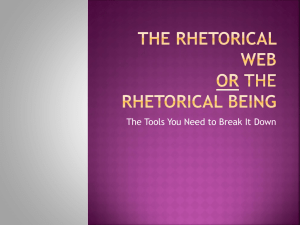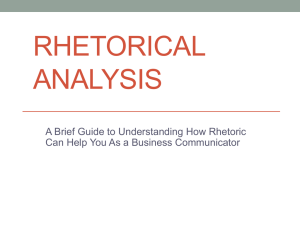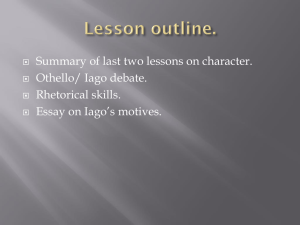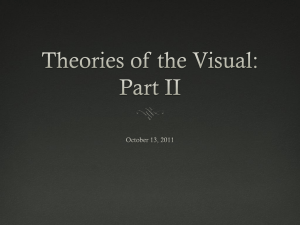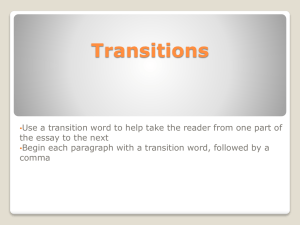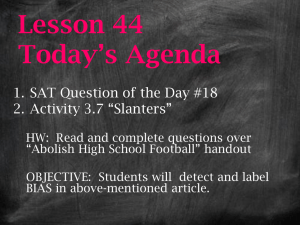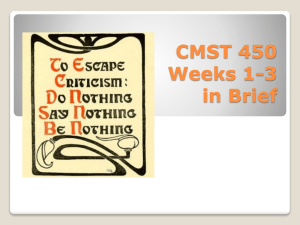Rhetorical Devices
advertisement
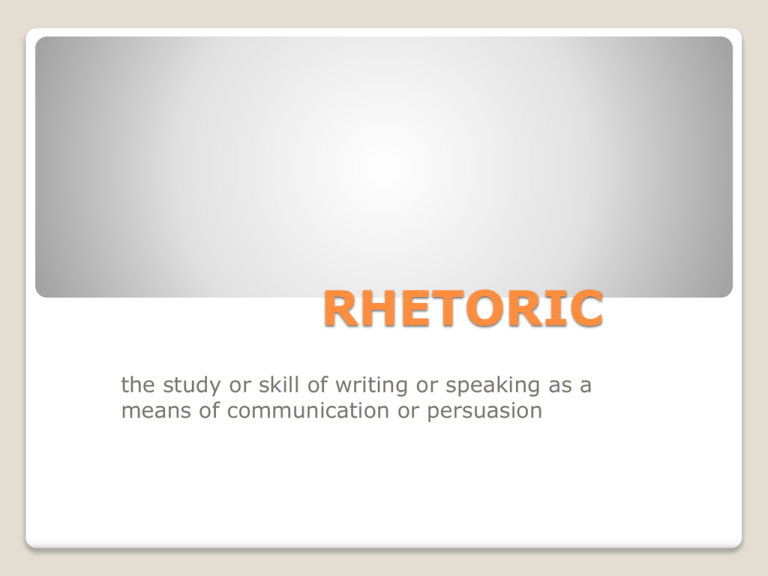
RHETORIC the study or skill of writing or speaking as a means of communication or persuasion RHETORIC “The duty and office of rhetoric is to apply reason to imagination for the better moving of the will.” --Francis Bacon (1561-1626): Advancement of Learning “[Rhetoric is] that discipline which studies all of the ways in which men may influence each other's thinking and behavior through the strategic use of symbols.” -- Douglas Ehninger (1972) RHETORICAL DEVICE a rhetorical device or resource of language is a technique that an author or speaker uses to convey to the listener or reader a meaning with the goal of persuading him or her towards considering a topic from a different perspective. Rhetorical devices used by writers and speakers FIGURATIVE LANGUAGE (metaphor, simile, personification, irony, overstatement, understatement, paradox, oxymoron). IMAGERY (figurative language or description used to evoke images in the mind) SOUND DEVICES (alliteration, assonance, consonance, onomatopoeia) Such rhetorical devices may be used to evoke specific emotional reactions in the reader or audience. There are other types of rhetorical devices used by writer and speakers. More rhetorical devices RESTATEMENT OF PHRASES The repetition of words or phrases at the beginning of successive phrases, clauses, or sentences is called ANAPHORA. The repetition of words or phrases at the end of successive phrases, clauses, or sentences is called EPISTROPHE. More rhetorical devices TRANSITIONS TRANSITIONS Transitions help to make your writing flow. There are several types of transitions a writer may employ. A brief summarizing statement of what has been discussed and what will be discussed A brief statement of what has been said and what will follow functions as a transitional summary that links sections of writing together. It provides clarity by keeping topics ordered and focused in the reader's mind. Ex. In the previous paragraphs, I have offered my analysis of the causes of this growing discontent. At this point, I would like to take up the subject of what might be done to remedy it. MORE TRANSITIONS Conceding an opposing view Anticipating an objection that might be raised by a reader and responding to it permits an argument to continue moving forward while taking into account opposing points. Ex. While some might say that this battle really had no effect on the outcome of the war, such a statement could arise only from ignoring the effect the battle had on the career of General Mars, who later became a principal figure in the decisive final conflict. MORE TRANSITIONS Asking a rhetorical question A question is "rhetorical" if it is asked merely for effect with no answer expected. The purpose of this figure of speech is not to secure a response but to assert or deny a point implicitly. A rhetorical question may serve as a subtle way of insinuating an idea that might be challenged by an audience if asserted directly. A rhetorical question allows the writer or speaker to control the direction of the discussion. Rhetorical question example Ex. "What can we do to free our consciences? There is one line of action by which we can do much. We can enlist the workingmen on behalf of our enfranchisement just in proportion as we strive with them to free the children. No labor organization in this country ever fails to respond to an appeal for help in the freeing of the children.” -- Florence Kelley Speaks out on Child Labor and Women’s Suffrage In this excerpt from her speech, Florence Kelley does not expect an answer; she is asking the question (and answering it) in order to gain the audience’s support of her proposal. This type of rhetorical question is actually called hypophora. EXAMPLE OF A TRUE RHETORICAL QUESTION So, then, do we want to continue a business model that guarantees we will lose more money next year than this year and more money than ever each coming year? A true rhetorical question differs from hypophora in that the writer does not answer it because the answer is self-evident. In other words, the expected answer is implied by the question itself, and is often just a yes or no. In the example above, the expected answer is “No, because businesses cannot function by losing ever-increasing amounts of money.” MORE RHETORICAL DEVICES PARALLELISM PARALLELISM Parallelism is the presentation of several ideas of equal importance by putting each of them into the same kind of grammatical structure. Each of the ideas is phrased similarly, making for a flowing continuous sentence Examples of parallel structure To think carefully and to write precisely are interrelated goals. = PARALLEL By forming two infinitives combined with adverbs, the writer has created a parallel structure and suggested that both ideas are equally important. To think carefully and precise writing are interrelated goals. = NOT PARALLEL By forming your subject from an infinitive and a gerund, you have created an unparallel structure that makes your sentence awkward and unclear. You could change your sentence so that your subject is made up of two infinitives (as seen above) or two gerunds (see below). Careful thinking and precise writing are interrelated goals. = PARALLEL Antithesis: Usually presented in parallel structure Antithesis Antithesis contrasts two ideas by placing them next to each other, almost always in a parallel structure. It's an effective way to clarify an idea since it shows how the idea differs from another. Example: To err is human; to forgive, divine. -Alexander Pope That's one small step for man, one giant leap for mankind. -Neil Armstrong MORE RHETORICAL DEVICES AND TECHNIQUES CLARITY CLARITY If you are not clear in your writing, your point will be lost. You can improve the clarity of your message in the following ways: Definition – In order to prevent confusion and increase clarity, it is sometimes necessary to provide your definition of a word or idea. Defining a word or phrase is a good technique to incorporate into your SAQ responses and expository essays. You may need to define a literary term to demonstrate your understanding. Think about the Dr. Seuss SAQ where you needed to demonstrate your understanding of alliteration. You may need to define a concept or an idea according to your perspective. For example, how would you define a “good teacher”? What qualities must a good teacher possess? Everyone has their own notion, so you would need to define the qualities that, in your view, make a teacher good or effective. In an expository essay, this definition becomes part of your explanation. In a short answer question, you would define and then SUPPORT/PROVE with text evidence. CLARITY, cont. Examples – Providing specific examples of an idea can help clarify the point you are trying to make. In your SAQ response, your quote or paraphrase serves as an example or proof to your claim. Examples are also a good way to explain your thesis statement in your expository essay. Details - By restating a word or idea and adding more detail, a writer can call attention to an expression that may otherwise be passed over. Ex. In my hunger, after ten days of overly rigorous dieting, I saw visions of ice cream - mountains of creamy, luscious ice cream, dripping with gooey syrup and calories. USING RHETORIC TO PERSUADE The persuasive speech and persuasive essay Should I go with Spock or Kirk? Logic or emotion? A little bit of both will take you a long way in persuading your audience. PERSUASIVE LANGUAGE Persuasive language can appeal to emotions and logic. Emotional appeals use charged language to appeal to the reader’s positive or negative feelings. Appeals to logic rely on facts and valid reasoning to sway the reader. Emotional appeals in persuasive writing The use of imagery, figurative language, anecdotes and emotionally charged words can be used to appeal to the reader’s or audience’s emotions. Rhetorical questions can also be used as an emotional appeal. Appeals to logic in persuasive writing Facts, statistics, expert opinions and explanations, and logical reasoning can be used to appeal to logic in persuasive writing. Florence Kelley speaks out on child labor and women’s suffrage In her speech on child labor and women’s suffrage, Florence Kelley appealed to logic through her use of facts about the various state laws. She also used logical reasoning to reach logical conclusions. However, Kelley also used imagery, figurative language, rhetorical questions, and emotionally charged language to elicit an emotional response from the audience. Reading and listening critically to persuasive arguments Critical listeners and readers can identify the different types of arguments used in persuasive writing and recognize the strength or weakness of the argument. Types of persuasive arguments and what to look for Cause/Effect: Is the effect really caused by what the speaker says caused it? Always True: Does one truth necessarily mean everything the speaker says is true? Straw Man: Is the speaker attacking a weak idea to avoid a strong truth? Slippery Slope: Speakers presume the results of a problem without proof. Bandwagon: Speakers assert that everyone thinks one way so you should, too. Types of persuasive arguments and what to look for, cont. Loaded Words/Scare Tactics: Some words cause fear. The speaker is trying to scare you into seeing things his way. Circular Logic: Because a speaker says you are something, you are. Red Herring: Speakers draw attention away from real issues. Two Wrongs: Pointing to the mistakes of others does not justify your mistakes. In politics, we call this mudslinging. RHETORIC Much like the Force in Star Wars, rhetoric can be used for good or for evil. You can use rhetoric for good and create a strong, convincing argument, or you can give in to the dark side and create a flawed argument that does not hold up under scrutiny. You must also be constantly vigilant when reading or listening to the rhetoric of another. The dark side of rhetoric can fool those who do not listen with a critical ear or read with a critical eye. Do not be seduced by the dark side of rhetoric. Don’t be led astray into believing a faulty argument. Read carefully, young Skywalker. May the Rhetoric be with you.


